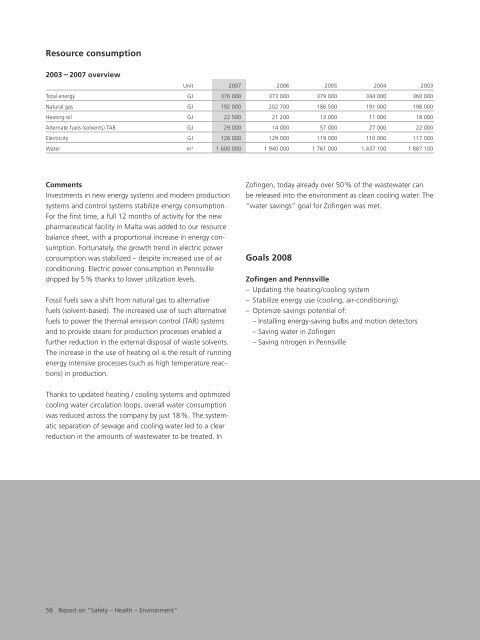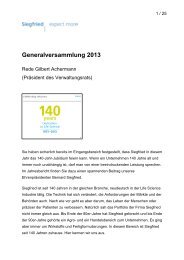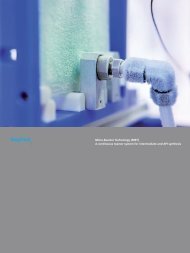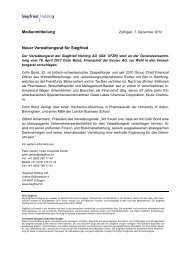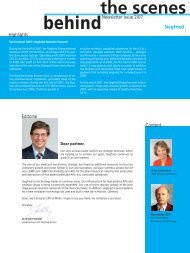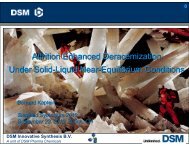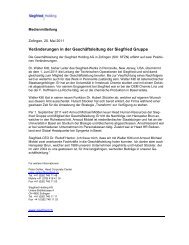Create successful ePaper yourself
Turn your PDF publications into a flip-book with our unique Google optimized e-Paper software.
Resource c<strong>on</strong>sumpti<strong>on</strong>2003 – 2007 overviewUnit 2007 2006 2005 2004 2003Total energy GJ 376 000 373 000 379 000 344 000 360 000Natural gas GJ 192 000 202 700 186 500 191 000 198 000Heating oil GJ 22 500 21 200 13 000 11 000 18 000Alternate fuels (solvents) TAR GJ 29 000 14 000 57 000 27 000 22 000Electricity GJ 126 000 129 000 119 000 110 000 117 000Water m 3 1 600 000 1 940 000 1 761 000 1,437 100 1 887 100CommentsInvestments in new energy systems and modern producti<strong>on</strong>systems and c<strong>on</strong>trol systems stabilize energy c<strong>on</strong>sumpti<strong>on</strong>.For the first time, a full 12 m<strong>on</strong>ths of activity for the newpharmaceutical facility in Malta was added to our resourcebalance sheet, with a proporti<strong>on</strong>al increase in energy c<strong>on</strong>sumpti<strong>on</strong>.Fortunately, the growth trend in electric powerc<strong>on</strong>sumpti<strong>on</strong> was stabilized – despite increased use of airc<strong>on</strong>diti<strong>on</strong>ing. Electric power c<strong>on</strong>sumpti<strong>on</strong> in Pennsvilledripped by 5% thanks to lower utilizati<strong>on</strong> levels.Fossil fuels saw a shift from natural gas to alternativefuels (solvent-based). The increased use of such alternativefuels to power the thermal emissi<strong>on</strong> c<strong>on</strong>trol (TAR) systemsand to provide steam for producti<strong>on</strong> processes enabled afurther reducti<strong>on</strong> in the external disposal of waste solvents.The increase in the use of heating oil is the result of runningenergy intensive processes (such as high temperature reacti<strong>on</strong>s)in producti<strong>on</strong>.Zofingen, today already over 50% of the wastewater canbe released into the envir<strong>on</strong>ment as clean cooling water. The“water savings” goal for Zofingen was met.Goals 2008Zofingen and Pennsville– Updating the heating/cooling system– Stabilize energy use (cooling, air-c<strong>on</strong>diti<strong>on</strong>ing)– Optimize savings potential of:– Installing energy-saving bulbs and moti<strong>on</strong> detectors– Saving water in Zofingen– Saving nitrogen in PennsvilleThanks to updated heating / cooling systems and optimizedcooling water circulati<strong>on</strong> loops, overall water c<strong>on</strong>sumpti<strong>on</strong>was reduced across the company by just 18%. The systematicseparati<strong>on</strong> of sewage and cooling water led to a clearreducti<strong>on</strong> in the amounts of wastewater to be treated. In56 <str<strong>on</strong>g>Report</str<strong>on</strong>g> <strong>on</strong> “Safety – Health – Envir<strong>on</strong>ment”


